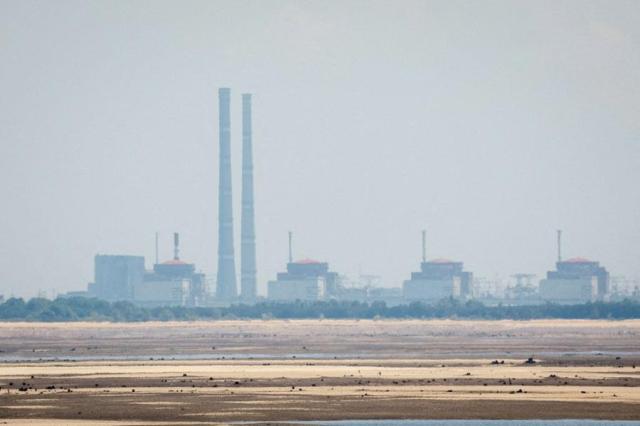
SEOUL, April 25 (AJU PRESS) - Russia's invasion of Ukraine has put the country's nuclear facilities at considerable risk. For example, on April 7 a drone attacked Ukraine's Zaporizhzhya Nuclear Power Plant. This attack on the largest nuclear power plant in Europe was a rare instance of a direct assault on a nuclear facility. While both Ukraine and Russia deny responsibility for the drone attack, it's clear that Russia's ongoing invasion has put the site at active risk.
Indeed, the director general of the International Atomic Energy Agency (IAEA), Rafael Mariano Grossi, has called the attack "a major escalation of the nuclear safety and security dangers in Ukraine."
Unfortunately, the Zaporizhzhya plant is not the only site in Ukraine where nuclear and radioactive safety is compromised by the ongoing war.
Radioactive pollution from nuclear reactors
Ukraine is a country with hundreds of industrial facilities across various sectors. Many of these facilities are now either under Russian occupation or close to active war zones.
Ukraine has four operating nuclear power plants including the Rivne, Khmelnytskyi, Zaporizhizhiya and South Ukraine plants.
The Zaporizhzhya site has six nuclear reactors, all six of which are currently in cold shutdown. However, Russian president Vladimir Putin has expressed an interest in restarting the Zaporizhzhya plant — a plan which should cause significant concern.
Ukraine also operates a smaller research reactor at the National Science Centre at the Kharkiv Institute of Physics and Technology. Since February 2022, the reactor has been in long-term shutdown (or a 'subcritical state').
Although the institute has sustained significant damage due to Russia's ongoing bombardment and shelling of Kharkiv, radiation so far has not been released from the reactor. Yet, the situation remains precarious.
In recent weeks Kharkiv has been targeted by Russian bombing with a particular focus on the city's energy infrastructure. On April 4 the nuclear research facility lost power as a result of Russian attacks necessitating the use of temporary generators to maintain the reactors subcritical state.
All nuclear reactors in Ukraine are at risk, however, the closer the site is to the front lines the greater the risk grows. That being said, it is not just the direct physical danger of attack which presents a risk to these facilities.
Nuclear power plants require constant maintenance, monitoring and control to ensure safe operation. A recent report by the Conflict and Environmental Observatory and Zoï Environment Network laid bare the risks of inadequate power, water and human oversight to the safety of these plants.
The destruction of the Kakhovka Dam in June 2023 raised serious concerns about the safe operation of the Zaporizhzhya plant. Earlier, the capture of the abandoned Chernobyl nuclear power plant by Russian forces in February 2022 set a dark precedent for the military occupation of a civilian nuclear power plant. The Chernobyl site also reminds us that nuclear radiation can contaminate an area far beyond the site itself.
Pollution from other sites
Aside from nuclear reactors, Ukraine hosts other sites that pose a radiation risk if sabotaged or mishandled.
Such sites include radioactive waste storage facilities, uranium mines and the site of the peaceful nuclear explosion at the Yunkom mine. While all these sites pose a potential radiation risk, the latter may already be spilling radioactive pollution.
In 1979, Soviet authorities carried out the controlled explosion of a 0.3 kiloton nuclear bomb 903 metres down inside the Yunkom mine. In 2018, Russian forces intentionally flooded the Yunkom mine, resulting in the (already potentially cracked) chamber containing the nuclear material to be submerged. There is a real risk that this water may allow radioactive pollution to spread across a wide area.
The risks are real
As long as there is war in Ukraine, the threats to nuclear and radiation safety are real. Regardless of whether there are direct attacks on sites with radioactive material or if disruptions inhibit their safe operation, the consequences of the radioactive contamination will be significant and long-lasting.
These threats should invigorate discussions around international nuclear safety norms and how they can be upheld during armed conflicts.
-------------------------------------------------------------------------------------------------------------------------
Nino Antadze is an associate professor, Environmental Studies at University of Prince Edward Island in Canada.
This article was republished under a Creative Commons license with The Conversation. The views and opinions in this article are solely those of the author.
https://theconversation.com/russias-invasion-of-ukraine-has-left-the-entire-region-at-a-heightened-risk-of-radioactive-pollution-227856
Copyright ⓒ Aju Press All rights reserved.

![[FOCUS] S. Koreas nuclear power industry regards Russia-Ukraine war as rare opportunity to bounce back from path of decline](https://image.ajunews.com/content/image/2022/08/26/20220826163524925190_278_163.jpg)